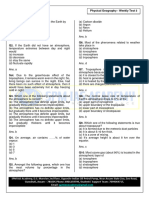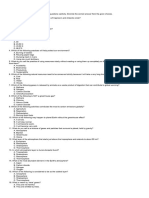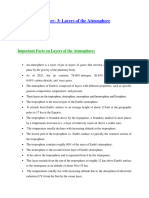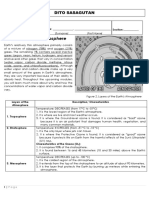Document
Uploaded by
BhDocument
Uploaded by
BhClass 7 Geography chapter 3
Text Questions & Answers
Q1. Answer the following in a word.
(a) The lowest layer of the atmosphere.
Ans. Troposphere.
(b) The layer which sends back radio signals to the earth.
Ans. Ionosphere.
(c) The incoming solar radiation received by the earth.
Ans. Insolation.
Q2. Answer the following questions in about 30 words.
(a) Mention the uses of the most plentiful gases of the atmosphere.
Ans. Nitrogen is the most plentiful gas occuring 78% of the atmosphere by volume and it is vital for plant
life. Oxygen makes up about 21% of the air by volume. Human beings and animals need oxygen to
breathe.
(b) Give the significance of the ozone layer to human beings.
Ans. Ozone layer absorbs ultraviolet rays from the sun. If these rays were to reach the earth, it would be
dangerous for the existence of the life forms on the surface of the earth.
(c) How is atmosphere heated?
Ans. The atmosphere does not get heated directly by the sun's rays. It absorbs very little of the solar
radiation. From the ground surface, the heat is transferred to atmosphere through the process of
radiation, conduction, convection and advection. Thus the atmosphere is heated up.
(d) Name the main pressure belts on the surface of the earth.
Ans. The main pressure belts on the surface of the earth are Equatorial Low Pressure Belt, Sub-tropical
High Pressure Belts, Sub-Polar Low Pressure Belts and Polar High Pressure Belts.
Q3. Choose the correct answer:
(i) The process of conversion of water vapour into water droplets is known as
(A) Evaporation. (B) Condensation.
(C) Sublimation. (D) Precipitation.
Ans. Condensation.
(ii) The condition of the atmosphere at a particular place and time is called
(A) Weather. (B) Climate.
(C) Pressure. (D) Temperature.
Ans. Weather.
(iii) Based on latitudinal location, Manipur
belongs to
(A) Tropical zone. (B) Torrid zone.
(C) Temperate zone. (D) Frigid zone.
Ans. Temperate zone.
Q4. Mark true or false against the following statements:
(a) The tropopause is the boundary between the atmosphere and the mesosphere.
Ans. False.
(b) Air pressure is measured by an instrument called thermometer.
Ans. False.
(c) Plant absorbs carbon dioxide to make its food.
Ans. True.
(d) Water vapour is absent in the lower atmosphere.
Ans. False.
(e) Torrid zone is the hottest part of the earth
Ans. True.
Prepared by Ch. Surajit.
You might also like
- (AnsKey) Physical Geography Weekly Test - 3 (Climatology and Oceanography)No ratings yet(AnsKey) Physical Geography Weekly Test - 3 (Climatology and Oceanography)6 pages
- PDF 4th Quarter Examination Science 7 - Compress100% (1)PDF 4th Quarter Examination Science 7 - Compress3 pages
- GG101 2023 Final Exam Practice Sample QuestionsNo ratings yetGG101 2023 Final Exam Practice Sample Questions22 pages
- ClassVIISocialScienceChapter-4Air[Geography]Worksheet8No ratings yetClassVIISocialScienceChapter-4Air[Geography]Worksheet82 pages
- PDF Test Bank for Meteorology Today, 10th Edition: C. Donald Ahrens download100% (2)PDF Test Bank for Meteorology Today, 10th Edition: C. Donald Ahrens download49 pages
- Test Bank for Meteorology Today, 10th Edition: C. Donald Ahrens - All Chapter Instant Download100% (3)Test Bank for Meteorology Today, 10th Edition: C. Donald Ahrens - All Chapter Instant Download49 pages
- Geography_Class_7_Chapter_4_Worksheet_UpdatedNo ratings yetGeography_Class_7_Chapter_4_Worksheet_Updated3 pages
- Complete Download of Test Bank for Meteorology Today, 10th Edition: C. Donald Ahrens Full Chapters in PDF DOCX100% (10)Complete Download of Test Bank for Meteorology Today, 10th Edition: C. Donald Ahrens Full Chapters in PDF DOCX47 pages
- Test Bank for Meteorology Today, 10th Edition: C. Donald Ahrens - Instantly Accessible In Full PDF Version100% (6)Test Bank for Meteorology Today, 10th Edition: C. Donald Ahrens - Instantly Accessible In Full PDF Version45 pages
- Geography Test 5 (PODP 2024) ExplanationNo ratings yetGeography Test 5 (PODP 2024) Explanation13 pages
- Social Science Test Chapter 4 Air Around UsNo ratings yetSocial Science Test Chapter 4 Air Around Us2 pages
- Corona A. Cabanilla National High School: Direction: Choose The Letter of The Correct AnswerNo ratings yetCorona A. Cabanilla National High School: Direction: Choose The Letter of The Correct Answer6 pages
- Selected MCQs On The Layers of The AtmosphereNo ratings yetSelected MCQs On The Layers of The Atmosphere26 pages
- Multiple Choice Questions (MCQS) Class: Vii Chapter - 1: Subject: GeographyNo ratings yetMultiple Choice Questions (MCQS) Class: Vii Chapter - 1: Subject: Geography4 pages
- Complete Physical Geography For Every ExamNo ratings yetComplete Physical Geography For Every Exam136 pages
- 9th ICSE Euro Geo QP With Sol Prelim - II 22.01.25No ratings yet9th ICSE Euro Geo QP With Sol Prelim - II 22.01.258 pages
- Biodiversity Erosion Watershed Amihan Habagat Greenhouse Effect Global Warming Latitude Longitude Equator RocksNo ratings yetBiodiversity Erosion Watershed Amihan Habagat Greenhouse Effect Global Warming Latitude Longitude Equator Rocks2 pages
- Earths Climate Past and Future 3rd Edition by Ruddiman ISBN Test Bank100% (44)Earths Climate Past and Future 3rd Edition by Ruddiman ISBN Test Bank7 pages
- STD VIITH QUESTION BANK-THE ATMOSPHERE-VII STDNo ratings yetSTD VIITH QUESTION BANK-THE ATMOSPHERE-VII STD3 pages
- SFG-2025-Level-1-Test-31-Solutions_221129-EngNo ratings yetSFG-2025-Level-1-Test-31-Solutions_221129-Eng38 pages
- This Is A Very Very Very Useful Socument by LolzNo ratings yetThis Is A Very Very Very Useful Socument by Lolz2 pages
































































